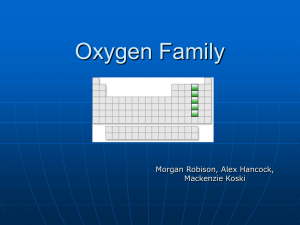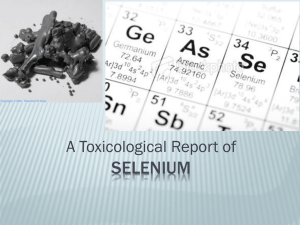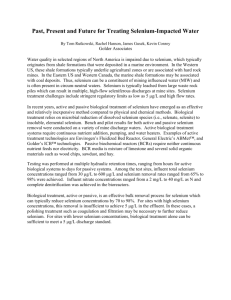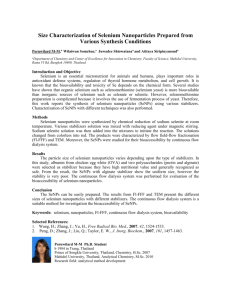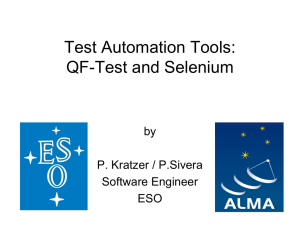1-30 PM Thomas Salon FG
advertisement
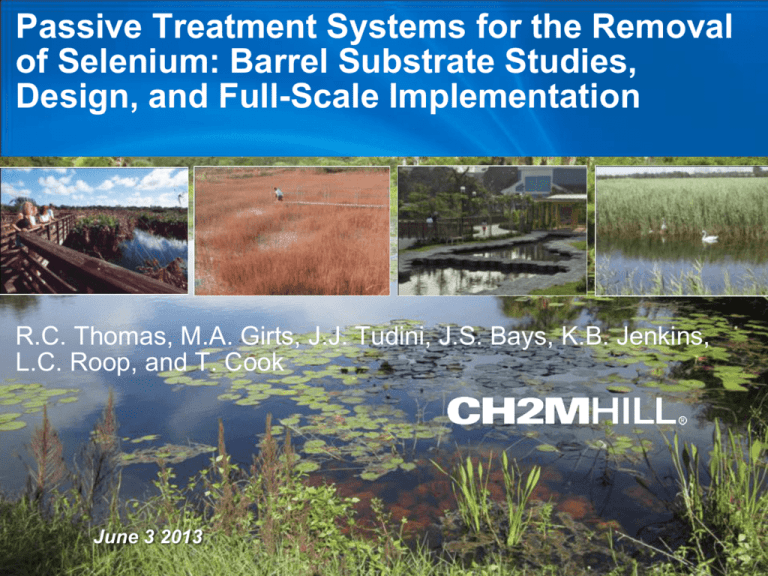
Passive Treatment Systems for the Removal of Selenium: Barrel Substrate Studies, Design, and Full-Scale Implementation R.C. Thomas, M.A. Girts, J.J. Tudini, J.S. Bays, K.B. Jenkins, L.C. Roop, and T. Cook June 3 2013 Copyright [insert date set by system] by [CH2M HILL Entity] • Company Confidential Overview of Presentation Outline NAMC Selenium Report 2010 Selenium Issues Mechanisms of Selenium Removal Historical Systems New Full Scale Systems Non-mining Examples By-Product Treatment Conclusions http://www.namc.org/docs/00062756.PDF Key Points about Selenium Control Se control can be critical to agriculture runoff, power generation, and mining industries Includes active and passive control technologies Passive treatment: – Uses natural processes to reduce and capture Se – Requires less operational effort and management – Demonstrated as a viable option for Se treatment Selenium Chemistry and Toxicity Trace concentrations are essential for diet Large concentrations can be toxic – Bioaccumulates; aquatic bird egg hatchability, fish larval deformities Oxidation state determines bioavailability, toxicity – Elemental (Se0) Not toxic, unavailable – Inorganic selenide (Se2-) Less bioavailable – Selenate (SeO42-, Se6+) Soluble, bioavailable, less toxic – Selenite (SeO32-, Se4+) Soluble, bioavailable, more toxic – Organic selenide (org-Se) Most bioavailable, most toxic • State NPDES effluent limits – 4.7 µg/L average month; 8.2 µg/L daily max Wetland Processing and Storage of Selenium SeO42 (CH3) 2Se Org-Se 2- SeO3 nanospheres HSe-1 Se0 Dissimilatory Reduction SeO42- → SeO32- → Se0 → Se2 Anaerobic process (Eh -200 mV, DO<2) Distribution in wetland sediments: 0:13:41:46 Wetlands: 90% reduction 10 - 16 days Bioreactors: 90% reduction <1 - 2 days Volatilization Organic + SeO32- → (CH3)2Se Volatilized from plant tissues 5-30% cumulative loss from sediments and plants Sorption Selenite sorbs to sediments and soil constituents: Fe-, Mn- or Aloxyhydroxides and organic matter Plant Uptake Rapid uptake Tissue concentrations increase but not detrimental No long term storage in plants; Se transferred to sediments Biological Selenium Treatment Organics + Selenite/Selenate + N + P + H2O + Se0 Order of reduction: New Cells + CO2 DO → NO2- → NO3- → SeO32- → SeO42- → ClO42- → SO42- 6 Selenium Passive Treatment Systems: Free Water Surface Wetlands Provide Starting Point Chevron’s Water Enhancement Wetland, Richmond CA Hansen et al, 1998 Area: Flow: Date: HRT: Se reduction: Se in: Se out: Volatilization: 36 ha ~6,540 m3/d since 1991 7-10 days 89% 20-30 µg/L <5 µg/L 10-30% Early Passive Treatment Data Site/ Date GPM pH Influent Se ug/L Effluent Se ug/L Percent Removal NV Gold Tailing (Aerobic) 1994 10 7.5 40 16 60% NV Waste Rock (BCR) 1994 6 2.7 22 <5 >78% Brewer Mine (BCR) 1995 1 2 1,500 50 97% Source: Gusek (2013) CLU-IN Bioreactor Overview Great Recent Progress in Bioreactor Design Full-Scale Sequential Systems Bob Nairn Pilot Projects www.sdcornblog.com Denitrifying Bioreactors for Agricultural Wastewater Treatment www.nps.gov Bioreactors for Minewater Treatment Case History Anaerobic “Bioreactor” Wetland Demonstration Showed High Efficiency in Minimal Area Grand Junction CO Walker and Golder. 2010. US Bureau of Reclamation Source: Volume: Flow: Date: HRT: Se in flow Se reduction: Se removal rate: Se out: TCLP gravel pit seep 4,380 ft3 2-24 gpm 9/08-10/09 2.4 d 1-34 µg/L 98% (90% winter) 16 mg/d/m3 0.5 µg/L <1 µg/L Se Case Histories: Pilot and Full-Scale Passive Treatment in WV Overview Location Two outlets assigned stringent selenium discharge standard: Valley fill drainage from reclaimed mines – 4.7 ug/L monthly mean – 8.2 ug/L daily max Conducted barrel studies to formulate substrate, calibrate model Designed two distinct systems based on landscape, space, treatment First system July 2011 Second system November 2011 VICINITY MAP PROJECT LOCATION Case History (2010) Pilot Study of BCR for Coal Mine Drainage 20% woodchips 35% sawdust 10% peat moss 5% limestone sand 25% hay, 5% composted manure 24 hr HRT ~ 17 mg/d/m3 media k20 Source: CH2MHILL (2010) ~1700 m/yr Barrel Study Confirmed Significant Post-Startup “Byproduct” Discharges Barrel Study Conclusions High strength substrate can remove Se at 12-hour HRT (24- to 48hour HRT for typical design) High strength substrate initially generates elevated concentration of secondary parameters (BOD, COD, low DO, etc.) Low strength substrate = lower Se removal rates but also lower secondary parameters Initial Se removal is largely as weakly adsorbed selenite with minor amounts removed as elemental Se Recommend additional long-term investigation 20 75.0 16 60.0 12 45.0 8 30.0 4 15.0 0.0 0 2/26/2011 6/6/2011 9/14/2011 12/23/2011 4/1/2012 7/10/2012 10/18/2012 Sample Date Se discharge limit - 4.7 mcg/l Inflow Total Se Flow (gpm) 1/26/2013 5/6/2013 Flow (gpm) Total Selenium (mcg/l) System A: Design Flow Set to Capture Load and Account for Inter-annual Variation Case History (2011-present) Two Full-Scale BCR Systems for Coal Mine Drainage Treatment 1 Replace existing sed pond Four cells-in-series: 1. 0.13 ac Downflow BCR 2 3 4 Barrel “B” mix 2. 0.14 ac Anaerobic upflow bed Barrel “A” peat 60 gpm base flow 100 gpm max 12 µg/L mean Se to <4.7 Source: CH2MHILL (2912) 3. 0.16 ac Fill-and-drain wetland Gravel; siphon level control 4. 0.11 ac Surface flow marsh Cell 1: Downflow Biochemical Reactor (BCR) Plan Profile SURFACE OVERFLOW STRUCTURE DWSE (1120.00’) DWSE (1120.00’) TOP OF SUBSTRATE (1117.16’) INLET WEIR TOP MEDIA ROCK FINISHED GRADE POND BOTTOM (1115.00’) INLET WEIR ORIGINAL GRADE CELL 1 CELL 1 BYPASS DITCH LIMITS OF HDPE LINER SURFACE OVERFLOW STRUCTURE m2 Type Media Plants Function 526 Downflow biochemical reactor Mixed organic None Selenium reduction Cell 2: Upflow Anaerobic Wetland Plan Profile TOP OF SUBSTRATE (1119.00’) BYPASS DITCH SURFACE OVERFLOW STRUCTURE DWSE (1120.00’) TOP MEDIA FINISHED GRADE SURFACE OVERFLOW STRUCTURE POND BOTTOM (1115.00’) ORIGINAL GRADE CELL 2 m2 CELL 2 Type Media Plants Function Sedges, rush Selenium reduction, Byproduct polishing LIMITS OF HDPE LINER DWSE (1120.00’) BYPASS DITCH 567 Upflow anaerobic ROCK Peat Cell 3: Fill-and-Drain Polishing Wetland Plan Profile CELL 3 DWSE (1117.00’) LIMITS OF HDPE LINER BYPASS DITCH SURFACE OVERFLOW STRUCTURE DWSE (1117.00’) BYPASS DITCH GRAVEL FINISHED GRADE POND BOTTOM (1113.00’) CELL 3 ORIGINAL GRADE POND BOTTOM (1113.00’) m2 Type Media Plants Function 648 Subsurface fill and drain Limestone gravel Cattails Byproduct polishing SURFACE OVERFLOW STRUCTURE Cell 4: Free Water Surface Polishing Wetland Plan Profile SURFACE OVERFLOW STRUCTURE ORIGINAL GRADE BYPASS DITCH DWSE (1114.00’) FINISHED GRADE CELL 4 SURFACE OVERFLOW STRUCTURE m2 CELL 4 POND BOTTOM (1111.00’) DWSE (1114.00’) 445 SOIL POND BOTTOM (1110.00’) Type Media Plants Function Free water surface Topsoil and ponded water Cattails Byproduct polishing PTS A: Completed Passive Se Treatment System Cell 1 Downflow Cell 2 Upflow Cell 3 Fill & Drain Marsh Cell 4 Surface flow Cell 1 Cell 2 Final Effluent Effluent Effluent 30 26 11 43 84 24 Parameter Influent BOD COD 13 11 NO2+NO3-N 3.6 1.5 2.4 1.2 Total Phosphorus 0.28 0.09 0.13 0.1 All units = mg/L a. Monitoring data from February through July 2012 Source: Thomas, R. (2011) On Balance, Natural Systems Favored (Coal Mine Drainage Example) Conventional Systems Natural Systems •BCR+wetland footprint fits (just) •Construction $762K •Natural processes •O&M $15K/yr •Can be made to fit •Construction $18MM •Engineered processes •O&M $500K PTS B: Higher Flow, Higher Concentration 230 gpm base flow 24 µg/L mean Se to <4.7 Source: CH2MHILL (2011) Five cells-in-series: 1. 2. 3. 4. 5. 0.12 ac Head tank 0.48 ac Upflow BCR 0.30 ac Upflow BCR 0.23 ac Surface flow marsh 0.38 ac Sedimentation pond Selenium Treatment Performance Achieved WQ Targets Source: CH2MHILL (2012) Case History (2011-2012): Field-Scale Demonstrations for Coal Mine Drainage in WV Three reactors: 35 ft x50 ft Duration: 290, 203, 203 days Se in: 2-25 µg/L Se out: 1-4 µg/L Se RR: 0.22 mg/d/ft3 » 7.7 mg/d/m3 » 5-10°C Source: J Bays (2011) Substrate: Haybales, MC Results used for full-scale plan: 250,000 ft3 substrate 800 gpm Se in: 14.88 µg/L Se out: 2.35 µg/L Source: Meek (2012) 10 hr HRT Case History (2008-present) Cold Climate Coal Mine, Alberta CA Source: Schipper & Rutkowski. 2012. www.asmr.org Date: 2008-present Type: Downflow VF Volume: 253 m3 Temp in: 3.2°C avg Se in 195 µg/L Se out: 33 µg/L (3 min) Se CR: >90% NO3N in: 36 mg/L NO3N RR: 5 g/d/m3 Se RR: 17 mg/d/m3 HRT: 4-8 days Year-round operation, passive Se (mg/L) Case History (2010-present) Continuous Se Removal in Mixed Organic Media for Saline RO Membrane Concentrate 0.050 0.045 0.040 0.035 0.030 0.025 0.020 0.015 0.010 0.005 0.000 TDS ~8 g/L Se in 20 µg/L Nitrate-N in 55 mg/L Bin 2 Influent (RO Conc.) Sources: CH2MHILL (2012) Image Source: Bays, J. (2012) www.usbr.gov Bin 2 Effluent Case History (2012): Treatment of Saline FGD Wastewaters Shows Selenium Removal Pilot Study Downflow Bioreactor Treatment Trend: Se Profile 1000 Total Se (µg/L Cell 1 k 289 m/yr zm 0.45 C* 1 ug/L 100 P75 P50 P25 Model 10 1 TDS Se in Source: CH2MHILL (2013) 2-10 g/L 129 – 290 ug/L 0 0.25 0.5 0.75 Fractional Area 1 Case History (2011-2012): Jeffrey Energy Center Pilot Wetland Westar Energy KS Vertical Flow Cells for Se, Hg Reduction1 >80% Se Reduction2 100% Hg Reduction2 TDS Se in Area ~2 g/L ~70 µg/L 2 ac 1 Sources: Morrison ,J. (2012) www.kdheks.com 2. Talley, M. (2012). Passive Treatment of Selenium: BCR Byproducts COD, Low DO, Color, Nitrogen (NH4+, NO3-/NO2-, TKN, etc), Phosphate, and Sulfide BOD, Recognition Why of the issue in early studies byproducts are an issue in Se treatment Expectations – Initial flush – Long-term generation of by products Functional Role of Aerobic Wetlands in Anaerobic + Aerobic Combination Surface Flow Wetlands Functions Treat BCR by-products – – – – – Victoria, TX Oxidize BOD, COD Trap particulates Assimilate excess nutrients Odor reduction Reduce color Se polishing to trace levels – Biological vegetation uptake, transformation and burial – Hydrologic attenuation to equalize possible variation in flows and concentrations Aerobic Polishing Cells (APCs): How Well Do They Work? Conventional Parameters Parameter Removal Efficiency Limit BOD 50 – 90% 2 – 10 mg/L TSS 50 – 90% 2 – 10 mg/L TN 50 – 90% 1 – 3 mg/L TP 40 – 90% < 1 mg/L Note: Removal efficiencies and effluent concentrations depend on influent concentration and hydraulic loading rate. Conclusions Se control can be critical to agriculture runoff, power generation, and mining industries Se control includes active and passive technologies Passive treatment: – Uses natural processes to reduce and capture Se – Requires less operational effort and management – Demonstrated as a viable option for Se treatment Site-specific applications based on Se concentration, flow rate, topography, and general influent geochemistry Early success achieved; optimization ongoing as systems age and performance is evaluated through changing climatic and flow conditions Acknowledgements Thanks to all of our collaborating partners in the West Virginia Coal Mining Industry Thanks to supporting engineering and science staff at CH2M HILL Questions


